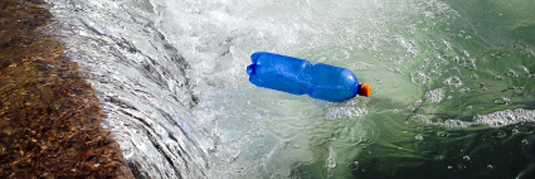Plastics in aquatic ecosystems
Plastic debris is practically indestructible and often ends up in the sea. Its long-term impact on aquatic ecosystems is unclear. This type of pollution can now be quantified precisely, and its repercussions for living organisms better understood.
21.08.2012

Synthetic plastics are an integral part of modern life. They are also well-nigh imperishable, and hence pose a massive waste disposal problem. A large proportion of this waste ends up in the sea. Indeed, a huge expanse of the North Pacific, the so-called Great Pacific Garbage Patch, is blanketed with plastic debris, which threatens marine life in the area. Ingestion of even small fragments of the brightly colored plastic by marine organisms can significantly perturb hormone metabolism and even block the gastrointestinal tract.
Microplastic particles in the millimeter to micrometer size class are distributed at least as widely, and are no less dangerous, especially since they can undergo “bioaccumulation” as they move up the food chain. Levels of pollution by debris of this sort in aquatic ecosystems has often been a rough estimation. That is now set to change. “With the aid of a new method, we can isolate and quantify ecologically relevant plastic particles from sediments down to the sub-millimeter range using a density-dependent separation technique,” says LMU biologist Professor Christian Laforsch.
Plastic under scrutiny
The new Munich Plastic Sediment Separator (MPSS) was developed in collaboration with researchers at the Institute of Hydrochemistry and Chemical Balneology at the TU Munich. The instrument allows one to extract and identify microplastic particles from aquatic sediments and to quantify their size distributions. “Our method is clearly superior to the approaches that have been tried in the past,” says Hannes Imhof, lead author of the new study.
With rates of separation and identification of up to 100%, the method achieves an unprecedented level of efficiency. This opens a broad range of applications for the new technique, in the recycling industry, for example. “Understanding the effects of plastic waste on aquatic ecosystems is an urgent research goal,” says Laforsch. “We can now precisely assess the levels of plastic pollution in aquatic ecosystems, and study its impact on the organisms that depend on these fragile habitats. And, of course, people belong in this category, since these systems provide us with essential drinking water and food.” (Limnology and Oceanography: Methods, July 2012)

